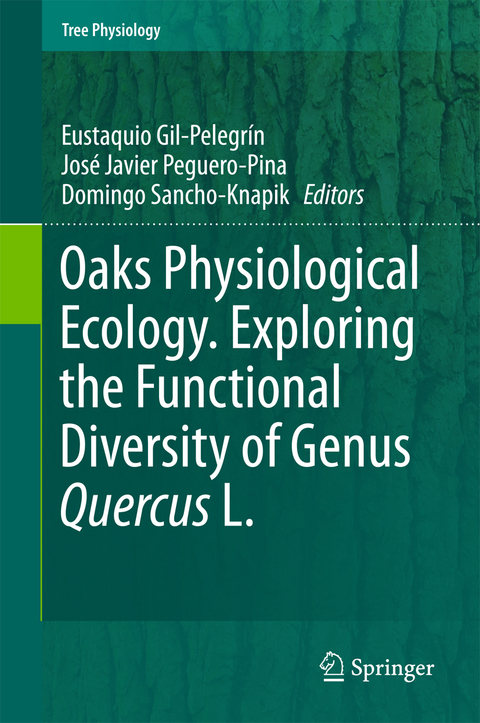
Oaks Physiological Ecology. Exploring the Functional Diversity of Genus Quercus L.
Springer International Publishing (Verlag)
978-3-319-69098-8 (ISBN)
With more than 500 species distributed all around the Northern Hemisphere, the genus Quercus L. is a dominant element of a wide variety of habitats including temperate, tropical, subtropical and mediterranean forests and woodlands. As the fossil record reflects, oaks were usual from the Oligocene onwards, showing the high ability of the genus to colonize new and different habitats.
Such diversity and ecological amplitude makes genus Quercus an excellent framework for comparative ecophysiological studies, allowing the analysis of many mechanisms that are found in different oaks at different level (leaf or stem). The combination of several morphological and physiological attributes defines the existence of different functional types within the genus, which are characteristic of specific phytoclimates.
From a landscape perspective, oak forests and woodlands are threatened by many factors that can compromise their future: a limited regeneration, massive decline processes, mostly triggered by adverse climatic events or the competence with other broad-leaved trees and conifer species. The knowledge of all these facts can allow for a better management of the oak forests in the future.
1. Oaks and people: a long journey together; Eustaquio Gil-Pelegrín et al.- 2. An updated infrageneric classification of the oaks: review of previous taxonomic schemes and synthesis of evolutionary patterns; Thomas Denk et al.- 3. The fossil history of Quercus; Eduardo Barrón et al.- 4. Physiological evidence from common garden experiments for local adaptation and adaptive plasticity to climate in American live oaks (Quercus section Virentes): implications for conservation under global change; Jeannine Cavender-Bares, José Ramirez-Valiente.- 5. Oaks under Mediterranean-type climates: functional response to summer aridity; Eustaquio Gil-Pelegrín et al.- 6. Coexistence of deciduous and evergreen oak species in Mediterranean environments: costs associated with the leaf traits of both habits; Alfonso Escudero et al.- 7. The role of hybridization on the adaptive potential of Mediterranean sclerophyllous oaks: the case of the Quercus ilex x Q. suber complex; Unai López de Heredia et al.- 8. The xylem anatomy and function of oaks; Elisabeth Maria Rogier Robert et al.- 9. The role of mesophyll conductance in oak photosynthesis: among- and within-species variability; José Javier Peguero-Pina et al.- 10. Carbon losses from respiration and emission of volatile organic compounds - the overlooked side of tree carbon budgets; Roberto Salomón et al.- 11. Photoprotective mechanisms in the genus Quercus in response to winter cold and summer drought; José Ignacio García-Plazaola et al.- 12. Growth and growth-related traits for a range of Quercus species grown as seedlings under controlled conditions and for adult plants from the field; Rafael Villar et al.- 13. Drought-induced oak decline - factors involved, physiological dysfunctions, and potential attenuation by forestry practices; Jesús Rodríguez-Calcerrada et al.- 14. Physiological keys for natural and artificial regeneration of oaks; Jesús Pemán et al.- 15. Competition drives oak species distribution and functioning in Europe: implications under global change; Jaime Madrigal-González et al.- Index.
| Erscheinungsdatum | 10.01.2018 |
|---|---|
| Reihe/Serie | Tree Physiology |
| Zusatzinfo | VII, 547 p. 115 illus., 83 illus. in color. |
| Verlagsort | Cham |
| Sprache | englisch |
| Maße | 155 x 235 mm |
| Gewicht | 988 g |
| Themenwelt | Naturwissenschaften ► Biologie ► Botanik |
| Schlagworte | biodiversity • Biomedical and Life Sciences • Botany & plant sciences • Botany & plant sciences • ecophysiology • forestry • Forestry & silviculture: practice & techniques • Forestry & silviculture: practice & techniques • Life sciences: general issues • photosynthesis • Phylogeny • plant ecology • Plant Physiology • Plant Systematics/Taxonomy/Biogeography • Quercus • Regeneration • systematic botany • Taxonomy & systematics • Taxonomy & systematics |
| ISBN-10 | 3-319-69098-1 / 3319690981 |
| ISBN-13 | 978-3-319-69098-8 / 9783319690988 |
| Zustand | Neuware |
| Haben Sie eine Frage zum Produkt? |
aus dem Bereich


